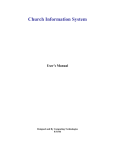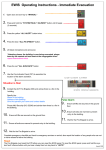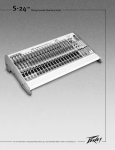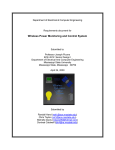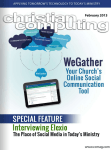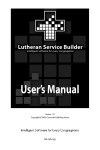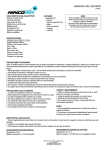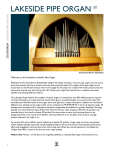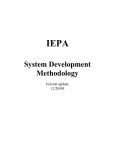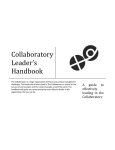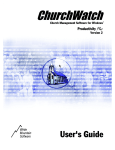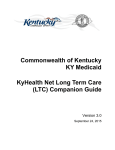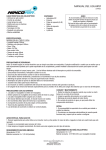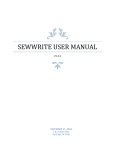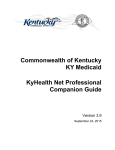Download STONE SOUP - The Redmon Family of Fort Wayne Indiana and
Transcript
More Than STONE SOUP A Stewardship and Giving Emphasis Program for Congregations Program User Manual Edward H Redmon 5226 Brookview Drive Fort Wayne, Indiana 46835 EMAIL: [email protected] More Than STONE SOUP A Stewardship and Giving Emphasis Program for Congregations TABLE OF CONTENTS Page: 3 Copyright Notice & Licensing Covenant 3 Welcome 4 Program Overview 6 Program Packets 7 Program Roadmap 8 Progress Reporting via Email 9 Program Team Formation 9 Program Team Installation 10 Team Meetings 10 Pre-Program Promotion and Publicity 10 Letters & Mailings 11 Prayer Chart 11 Stone Soup Sunday 12 Chancel Drama 12 Blessing of the Stones 13 Challenge of the Stones 13 Stone Soup Luncheon 13 Temple Talks 14 Bulletin Inserts 14 The Sermons 14 Growth Giving & the Charts 14 Estimate of Giving Cards 15 Leadership Commitment 15 Celebration Sunday 16 Celebration Banquet 16 Doing the Math 17 Post Program Follow-up 17 Looking Ahead 18 Seven Principles of Christian Discipleship 18 Stewardship Basics 18 History of Revisions and Updates More Than Stone Soup Version 3 Copyright © 2006-2011 Redmons LLC, Fort Wayne, In Program User Manual – Page 2 COPYRIGHT NOTICE & PROGRAM LICENSING COVENANT More Than Stone Soup, the program, manual contents, program roadmap and the ten individual packet contents are the copyrighted, proprietary intellectual property of Edward H. Redmon, Redmons LLC, Fort Wayne, Indiana. Free licensing providing a onetime right to use the program requires the signing of the Program Licensing Covenant. Said covenant requires adherence to the program schedule and details, and necessitates congregational feedback following program conclusion. Attempting to cut corners or skipping portions of the program not only violates the Program Licensing Covenant but also contributes to the potential for failure. Take the time needed and do it right! The covenant must be signed and returned prior to program use. Program packets will not be available, and materials beyond the Start-Up packet will not be delivered until the congregation’s Governing Board has voted and the signed Covenant is returned. Once the Governing Board has taken an affirmative vote, complete the Covenant, obtain the necessary signatures and return an original of the Covenant to Redmons LLC via USPS. Please use the Check List provided with the Program Start-Up Packet. To use or attempt to use any portion of the program materials prior to satisfying the Program Licensing Covenant is deemed a violation of the Copyright. The Program Licensing Covenant licenses a one time use only. The Program Licensing Covenant must be renewed each time the program is used. WELCOME Welcome to More Than Stone Soup. Thank you for completing and returning the signed Program Licensing Covenant. At this time you should be working on preliminary tasks leading up to program Week #1. Please allow enough time. As you read this manual, week #1 should be about four weeks away. Please read the complete manual, make copies for each of the Program Team Leaders, and encourage all of them to read the manual completely, as well. When assembling the manuals, include all of the materials received in the Program start-Up Packet, the Program Packet, the Chancel Drama and the Post Program Packet. Distribute materials from the remaining packets as you determine appropriate, perhaps limiting distribution to only those who are involved in any given week or event. Pray several times daily for your congregation and for your giving emphasis program. Prayer is too important to be omitted from the program. Remember to use the Email Progress Reports to keep in touch and to seek help with anything that seems to be a problem for you. Instructions for the Email Progress Report can be found later in the manual. We want you to be successful, so please, keep in touch. Well, that’s about it. We look forward to your first progress report. Throughout the program we will be praying for the spiritual growth of your congregation and your financial success. Ask for help should you need it. We are here for you. Peace and blessings... Ed More Than Stone Soup Version 3 Copyright © 2006-2011 Redmons LLC, Fort Wayne, In Program User Manual – Page 3 PROGRAM OVERVIEW More Than Stone Soup spans about nine weeks, including the preparation time, the six Sunday events, and some weeks of pre and post administration. A program schedule “Roadmap” was included in the “Start-Up Packet.” You may want to download a new one since the Roadmap is updated frequently as new ideas are offered. Complete instructions for the program are included in this Program User Manual. All supplemental materials referenced in the manual are included in one of the “Program Packets.” The contents of the packets are referenced later in the Manual. More Than Stone Soup was developed with the following objectives in mind: • • • • • • • • To re-introduce the Seven Principles of Christian Discipleship. To heighten an awareness among parishioners to the extent of God’s Generosity. To teach giving as an expression of our faith and trust in God. To encourage growth giving that will lead to tithing and beyond. To strengthen understanding and commitment to the judicatory at all levels. To encourage volunteerism within congregations, communities and the judicatory. To identify and develop strong congregational Lay Leaders. To provide an emphasis and giving program that is both engaging and affordable. Now, what if your annual congregational stewardship and giving emphasis program could satisfy these objectives – and be fun, too? Well, More Than Stone Soup is just that—a serious approach to giving that is fun for the congregation!! From the Stone Soup Sunday Chancel Drama through to the Celebration Sunday Banquet, the program is packed with fun things while focusing on giving as a response to God’s generosity. Stones are blessed, distributed and carried as a reminder that God, in his generosity, provides far more than mere soup stones to sustain us in this life. The More Than Stone Soup program implementation spans six Sundays and includes the Installation of the Team, the Stone Soup Sunday with Chancel Drama and Stone Soup Luncheon, three additional Sundays for Temple Talks and sermons, and ends on Celebration Sunday with the completion of the Estimate of Giving Cards and the closing Celebration Banquet. Set aside some additional time prior to and following the program start for planning, preparation, administration, follow-through, etc. More Than Stone Soup avoids the need and expense for catered meals and outside speakers. In concert with a Pastoral Calling, your Pastor serves as primary speaker and teacher. Of course, the congregation can choose to engage an outside speaker, but it really is unnecessary. A member is named as Program Coordinator and oversees the program. Program Coordinators should make every effort to engage as many parishioners as possible in the program. More Than Stone Soup Version 3 Copyright © 2006-2011 Redmons LLC, Fort Wayne, In Program User Manual – Page 4 A Prayer Chart is used as a means for encouraging growth in our relationship with God. Every congregant, including shut-ins, should be encouraged to sign up for at least one day of prayer. Prayer instructions and guidelines are provided as a Bulletin Insert master. The Chancel Drama can be used as it is written or it can be tweaked in ways that make it personal to the congregation. Please Note: the Narrator is the only one with a speaking part. This avoids the need for the cast to memorize lines and should make recruiting cast members much easier. The Narrator can be situated up front or can be located out of sight. The drama is intended to be a light presentation, and should be fun for both the cast and the congregation. Avoid making this a “heavy” performance. Ham it up! Allow the congregation a laugh or two. Following the drama, Pastor delivers a brief Homily recapping the points of the drama. A Homily outline is provided. On Stone Soup Sunday, small smooth stones are blessed and distributed to worshipers as they leave the Sanctuary on their way to the Stone Soup Luncheon. Parishioners are instructed to carry the stones with them at all times for the duration of the program. Each time the stone is encountered, be it in a purse or trousers pocket, the stone serves as a reminder to contemplate God’s generosity and grace. Part of the fun in all this is the challenge; “To catch someone without their stone.” Anyone caught without their stone owes the “Soup Pot” a dollar come Sunday morning! Two meals are an intricate and necessary part of the program. The first, the Stone Soup Luncheon, takes place following the Chancel Drama. This is very much a basic meal limited to chicken-vegetable soup with shredded or cubed chicken, and maybe a slice of bread with butter. Water is the drink for the meal; no coffee, tea, milk, soda, juice, etc. The meal is to take on the characteristics of the meal eaten by the villagers in the Chancel Drama. The congregants are the villagers for this meal and provide the meal as a “carryin” as did the villagers in the story. Avoid anything that would cause the Stone Soup Luncheon to appear purchased or catered in any way. The second meal takes place on Celebration Sunday. This meal is to be a banquet complete with soup or other appetizer, a salad, a main course with meat, potatoes and vegetables, and lots of desserts. With this meal we joyfully celebrate God’s abundant grace and the many blessings to which we are recipients. This meal is a “carry-in” also, but the Governing Board may wish to purchase the meat for the meal; chicken, ham, roast beef, Swiss steak, etc. The Celebration Sunday Estimate of Giving Cards provides the “Estimate of Giving” exercise so important to any giving emphasis program. These cards include an estimate for both financial giving and also a giving of one’s time and intellectual gifts to the congregation’s ministry. The Leadership completes estimate of giving cards early and the results are reported to the congregation the week prior to Celebration Sunday. A spreadsheet is provided for doing the math when calculating the congregation’s giving growth. The Right to Use Program Licensing Covenant mandates feedback from congregations following their program completion. Information from the feedback surveys is accumulated and numerically compiled for analysis. The data, along with any feedback More Than Stone Soup Version 3 Copyright © 2006-2011 Redmons LLC, Fort Wayne, In Program User Manual – Page 5 survey comments, is then used to influence any improvements in future releases of the program. Identity of reporting congregations and their associated results is considered confidential information and will not be divulged to anyone without specific written permission of the congregation’s Church Council. PROGRAM PACKETS The More Than Stone Soup program is delivered as a series of downloads from one of our two websites. The program is contained in several separate program packets: Program Start-Up Packet Program Packet Week #1 Program Packet Week #2 Program Packet Week #3 Program Packet Week #4 Program Packet Week #5 Program Packet Week #6 Program Packet Post Program Packet The Program Start-Up Packet contains the Program Licensing Covenant and a preliminary start-up check-List. Once the Covenant is returned to Redmons LLC, the Program Packet and the remaining packets are made available. Collectively, the packets contain all the printed material and instructions necessary for a successful giving emphasis program. The packets can be downloaded as needed or they may be downloaded all at once. Once available, at least the Program Packet, Chancel Drama Packet and the Week #1 and #2 Program Packets should be downloaded at the onset. The Program Packet contains the Roadmap and Program User Manual among other things. All other packets supplement the Program User Manual, and contain copy masters and other instructions you will need for any given week. Packet contents are as follows: PROGRAM PACKET Road Map Program User Manual Chancel Drama Stewardship Basics Seven Principles of Christian Discipleship Estimate of Giving Card Master Instructions for Weekly Progress Reports via Email WEEK #1 PACKET Sermon Outline [Why a Giving Emphasis Program] [Brief Order for the Team Installation] Temple Talk [Program Introduction] Bulletin Insert [Prayer] Draft of Letter #1 More Than Stone Soup Version 3 Copyright © 2006-2011 Redmons LLC, Fort Wayne, In Program User Manual – Page 6 WEEK #2 PACKET Stone Soup Homily Notes Bulletin Insert [Challenge of the Stones] Brief Order for the Blessing of the Stones Stone Soup Luncheon Table Prayer WEEK #3 PACKET Sermon Outline [Seven Principles of Christian Discipleship] Temple Talk [The Many Facets of Our Ministry] Bulletin Insert [Christian Discipleship] Leadership Meeting Devotional Outline WEEK #4 PACKET Sermon Outline [A Willing Heart – Exodus 25 & 35-37] Temple Talk [Needing to Give & Giving to Needs] Bulletin Insert [An Expression of Faith] Leadership Commitment Report Outline WEEK #5 PACKET Sermon Outline [A Theology for Giving] Temple Talk Outline [Growth Giving & Commitment] Bulletin Insert [Why Estimate Our Giving] Draft of Letter #2 WEEK #6 PACKET Sermon Outline [Celebrating God’s Grace and Generosity] Draft of Letter #3 Celebration Banquet Table Prayer Results Reporting Format POST PROGRAM PACKET Outline for Final Team Meeting Outline for Final Report to the Governing Board or Church Council Questionnaire Due Redmons LLC Listing of Other Good Giving Response Programs PROGRAM ROADMAP The Program Schedule and Timeline, or Roadmap, is included in the Program Packet. This document becomes your roadmap on your travels through the weeks ahead. The Roadmap includes a front page containing instructions and Program Team List, and three pages of schedules. Use this roadmap as a guide throughout the program and do not deviate from the schedule. All Program Team Members should be given a copy of this document, along with a copy of this manual, at the first Team Meeting. Use the Roadmap as a guideline for all Team Meetings. Treat the schedule as the ultimate authority when planning throughout the program. More Than Stone Soup Version 3 Copyright © 2006-2011 Redmons LLC, Fort Wayne, In Program User Manual – Page 7 PROGRESS REPORTING VIA EMAIL Beginning when you receive the Program Packet, submit an informal weekly progress report each Sunday afternoon via Email. Place “Stone Soup Progress Report” in the Subject line so our email client will sort it to the proper folder and we will see it when it comes in. On the first line of the body of the Email begin with an indication of where you are in the program overall: Pre-Program, Week # or Post Program. Report briefly on your progress over the last week and acknowledge any program packets that you have downloaded since your last progress report. This will help us to know that you have all that you need to continue with the program. Report any problems that you might have had and ask for any help you might need. We need to know where you are in the scheme of things before we can help you. Address your Progress Reports to: [email protected] PROGRAM TEAM FORMATION Select the Program Team Members carefully. Recruit as many as possible from the members of the Governing Board (Church Council). Remember, Pastor and the Governing Board are to be placed in visible positions of leadership. Also remember, the more of your congregants that are involved in the giving response program the more effective the program will be. Encourage your team members to enlist more members than what might be necessary. That way, more are involved and each will be required to do less. All team members must commit to attending weekly Team Meetings. Program Team job descriptions are as follows: PROGRAM COORDINATOR: This team member has ultimate responsibility for the execution of the giving emphasis program. The Program Coordinator selects all other team members with concurrence of Pastor. The Governing Board may want to have a say in the selection process, as well—and that is O.K. This position works closely with Pastor throughout the program execution. PUBLICITY-COMMUNICATIONS COORDINATOR: This team member is responsible for all posted materials, all newsletter articles, Email promotional posts, all letters mailed via USPS, and other correspondence. This should be the first position filled by the Program Coordinator so the publicity-promotion campaign can begin as early as possible. PRAYER CHART COORDINATOR: The creation, populating and posting of the Prayer Chart is the responsibility of this team member. This is a good position for a shut-in or someone with limited mobility—so long as the person has no problem making phone calls. The Prayer Chart Coordinator monitors the Prayer Chart and solicits folks to sign up for any days that are not adequately covered. Each day the Prayer Chart Coordinator makes follow-up calls providing a 48 hour reminder for those who have signed up to pray. In larger congregations, additional help might be needed to make all the calls. Again, this team member should be selected early. More Than Stone Soup Version 3 Copyright © 2006-2011 Redmons LLC, Fort Wayne, In Program User Manual – Page 8 TEMPLE TALKS COORDINATOR: Selecting Temple Talk speakers and ensuring the talks happen is the responsibility of this team member. The Temple Talk Coordinator should deliver no more than one temple talk himself/herself. The speakers, including the coordinator should all be selected from the Governing Board members if possible. STONE SOUP DRAMA DIRECTOR: This team member recruits the Chancel Drama Cast and directs the Chancel Drama. The Director needs a good sense of humor, and must be willing to conduct as many rehearsals as is necessary to produce a quality performance. STONE SOUP LUNCHEON COORDINATOR: This team member has two responsibilities; the Stone Soup Luncheon, and refreshments for the Leadership Meeting. This coordinator is responsible for all aspects of both events, including lunchroom setup and tear down, kitchen help and servers, and coordinating the signup of congregants for providing food dishes for the carry-in. For the Leadership Meeting, the coordinator determines what will be served and coordinates the signup of congregants for providing the desserts, etc., for the meeting. The Stone Soup Luncheon Coordinator must adhere to the luncheon plan found elsewhere in this manual. CELEBRATION BANQUET COORDINATOR: This team member coordinates the Celebration Sunday Banquet, and is responsible for all aspects of this meal. Tasks include planning the banquet menu, including the recruiting of the lunchroom setup and tear down team, kitchen help and servers, and coordinating the signup of congregants for providing food dishes for the carry-in. The Celebration Banquet Coordinator must adhere to the banquet plan found elsewhere in this manual. FINANCE & DATA COORDINATOR: This team member prepares the results spreadsheet and processes the Estimate of Giving Cards as they come in. The coordinator prepares the financial reports and, if requested, prepares a Congregational Giving Profile. The coordinator must understand the importance of giving records confidentially and must agree to use discretion when collecting and processing data. PROGRAM TEAM INSTALLATION During worship on Sunday morning of Week #1, at the appropriate place in the worship service, the Program Coordinator is introduced to the assembly. The Program Coordinator then identifies the other team members and invites them to come forward. When all are present Pastor installs the team using the Brief Order for the Installation of Program Team Members. The brief Order is included in the Week #1 Program Packet. TEAM MEETINGS The Program Coordinator is to conduct weekly team meetings. The meetings provide a place for discussing the events of previous weeks and planning for the coming More Than Stone Soup Version 3 Copyright © 2006-2011 Redmons LLC, Fort Wayne, In Program User Manual – Page 9 weeks. The Team Meetings are to begin in prayer. The Program Schedule and program packet content for upcoming weeks should be reviewed at each meeting. All team members are expected to attend the Team Meetings. PRE-PROGRAM PROMOTION AND PUBLICITY Promoting the program should begin at least four weeks prior to Sunday of Week #1. Publicity includes posters, newsletter articles, Email postings (optional), website and promotions included in the announcements made just prior to the start of worship on at least the two Sundays prior to Week #1. Posters should be created and placed around the church several weeks in advance of the Week #1 Sunday. Avoid a formal appearance by using artwork and letter fonts that are fun and inviting in appearance. If you have located the cauldron prop for the chancel Drama, it is fun to place that out as a display. Attach a sign to the cauldron which reads; “Stone Soup – Coming soon to a Sanctuary near you.” or something similar. If you have the rubber chicken, you can place that in the cauldron as well, head down with the feet sticking out of the pot. If time allows, place an article in the newsletter in the month prior to program startup and also the months in which the program is ongoing. Again, keep the articles light, suggesting the fun that is coming with the program. Sunday morning announcements should take on an air of invitation. Avoid verbiage, posture or attitude that might suggest to the congregants something other than an invitation to voluntary involvement in the program. LETTERS & MAILINGS Three mailings are suggested in support of your emphasis program. The first is mailed on Monday of week #1, following the introduction and installation of the Program Team and the introduction of the Prayer Chart. This letter formally announces the start of the program, announces critical program dates, and invites all members to daily prayer. The wording of the letter may be modified or tweaked, but the message and spirit this mailing conveys must be preserved. Congregations who are comfortable with the circulation and readership of their newsletter may choose to place the contents of this first letter in their newsletter thereby saving the cost of one mailing. However, if any doubt exists as to what might be the effectiveness of using the newsletter for this announcement—then MAIL the letter via USPS. If there is doubt... mail it out! The second letter is mailed on Monday of week #5. The message here is to remind your congregants of the Celebration Banquet and other festivities that will occur next Sunday. This is one final opportunity to emphasize the importance and the need for planning of weekly offerings. To assist in the planning a Growth Giving Step Chart is More Than Stone Soup Version 3 Copyright © 2006-2011 Redmons LLC, Fort Wayne, In Program User Manual – Page 10 included in the mailing. This letter is far too important to be distributed as a newsletter article. Mail this via USPS. The letter is not to be thought of as an optional piece of the program. Mail it! Letter number three is to be mailed on Monday of week #6, the day after Celebration Sunday. The mailing is addressed to non-participants only, includes an Estimate of Giving Card and asks them to consider a response to the program. Do NOT mail this to anyone who has announced a desire to opt out of the program. It will only cause hard feelings. PRAYER CHART The importance of this program feature cannot be overstated. A Prayer Chart is used as a means for encouraging growth in our relationship with God. Every congregant, including shut-ins, should be encouraged to sign up for at least one day of prayer. Prayer instructions and guidelines are provided as a Bulletin Insert master. The Prayer Chart should begin one week prior to the Sunday of Week #1. This will require the Prayer Chart Coordinator to solicit prayer partners in advance of Week #1 to ensure the first two weeks of the campaign are covered. Members of the Governing Board and other congregational leaders should be the first to sign the Prayer Chart. Again, Pastor and the Governing Board are to be placed in visible positions of leadership. The Prayer Chart provides the opportunity for identifying these leaders as persons involved and committed to the program. STONE SOUP SUNDAY Sunday of Week #2 is Stone Soup Sunday. The Chancel Drama is performed today, the Challenge of the Stones is introduced and explained, the stones are blessed, distributed, and the congregation gathers to partake of the Stone Soup Luncheon. It is important to promote this day ensuring a large turnout. Much of what follows depends on congregants being familiar with the message of the drama and the follow-up homily. Attendance on Stone Soup Sunday, more than any other, can make or break the success of the program. Members absent on Celebration Sunday can be contacted during the week following and encouraged to participate. Stone Soup Sunday, however, is difficult to repeat. A mood, or attitude, is created with the events of Stone Soup Sunday that carry through the weeks which follow. It is important that Stone Soup Sunday be well attended. CHANCEL DRAMA This is to be a very light and fun performance. The Chancel Drama can be used as it is written or it can be tweaked in ways that make it personal to the congregation. Please Note: the Narrator is the only one with a speaking part. This avoids the need for the cast to More Than Stone Soup Version 3 Copyright © 2006-2011 Redmons LLC, Fort Wayne, In Program User Manual – Page 11 memorize lines and should make recruiting cast members much easier. The Narrator can be situated up front or can be located out of sight. The drama is intended to be a light presentation, and should be fun for both the cast and the congregation. Avoid making this a “heavy” performance. Ham it up! Allow the congregation a laugh or two. If the majority of those present are not drawn into some laughter during the performance then success was not realized. The drama cast should dress as villagers if at all possible. The absence of speaking parts provides freedom to develop their respective roles via body posture and gesturing. An example: when the script falls for a villager to provide fresh peas for the soup, frozen peas are offered instead. When the narrator repeats with, “I said, fresh peas.” the villager can offer a shrug of the shoulders in response. If developed properly it will get laughs. Following the drama, Pastor delivers a brief Homily recapping the points of the drama. A Homily outline is provided. The Homily invites the congregation to seriously consider the blessings we all enjoy. However, do not overdo the seriousness to a point which would undo the fun the congregants enjoyed previously. The homily can deliver a meaningful stewardship message without totally spoiling the mood. Have fun. BLESSING OF THE STONES On Stone Soup Sunday, small smooth stones are blessed and distributed to worshipers as they leave the Sanctuary on their way to the Stone Soup Luncheon. The blessing and distribution can take place following the Luncheon, however, it presents the risk for missing those who might not attend the Luncheon. Parishioners are instructed to carry the stones with them at all times for the duration of the program. Each time the stone is encountered, be it in a purse or trousers pocket, the stone serves as a reminder to contemplate God’s generosity and grace. Anyone who was not in worship when the stones were distributed should be offered a stone on a subsequent Sunday. Carrying the stone is part of the program dynamics. Suitable stones are available at most stores selling artificial flowers, crafts items or aquarium supplies. The stones come in various sizes, are sometimes marketed as “river stones” or “polished stones” and sell for about a dollar per pound. Usually a three pound bag provides more than enough stones for the average congregation. A variety of sizes should be offered and members should be allowed to choose a stone from a basket or bowl rather than just handed a stone. Stones the size of a nickel seem to be the most popular. Caution families with children that stones can present a choking hazard and should not be given to small children. Stress caution. CHALLENGE OF THE STONES Part of the fun in all this is the challenge; “To catch someone without their stone.” Anyone caught without their stone owes the “Soup Pot” a dollar come Sunday morning! More Than Stone Soup Version 3 Copyright © 2006-2011 Redmons LLC, Fort Wayne, In Program User Manual – Page 12 Each Sunday during the Temple Talk, the speaker should invite anyone who was ‘caught’ without his stone over the past week to come forward and “pay up.” Have the Stone Soup caldron handy each Sunday morning for collecting the fines. Sometimes it can be fun for a smaller child to hold the pot. Have fun with this. Anyone who was not in worship when the stones were distributed should be offered a stone on subsequent Sundays. Without a stone they cannot participate and that diminishes both the fun and the impact of the program. THE STONE SOUP LUNCHEON The Stone Soup Luncheon takes place following the Chancel Drama. This is very much a basic meal limited to chicken-vegetable soup with just a little shredded or cubed chicken, and maybe a slice of bread with butter. Water is the drink for the meal; no coffee, tea, milk, soda, juice, etc. The meal is to take on the characteristics of the meal eaten by the villagers in the Chancel Drama. The congregants are the villagers for this meal and provide the meal as a “carry-in” as did the villagers in the story. Avoid anything that would cause the Stone Soup Luncheon to appear purchased or catered in any way. The table settings should be sparse with maybe some large stones as centerpieces. Use folded paper towel squares as napkins. If possible, avoid using the church’s good china or monogrammed dishes. Provide bowls only and a small saucer or dessert plate for the bread. Provide a spoon and a knife only. Omit the fork. Keep it sparce. It is probably best if the soup making is assigned to several people. By asking several individuals to make soup more can be involved. Those attending the Luncheon can then choose from the several pots of soup available to them. Others can be assigned to bring bread and butter. As a rule of thumb, usually the more who are involved in the program the better the response. TEMPLE TALKS Beginning with Week #1, a Temple Talk takes place during Worship each Sunday. Use the Road Map schedule to determine which Temple Talk is to be used. Beginning with Week #3, include an invitation for members to come forward and pay their fine relative to the Challenge of the Stones. Temple Talk materials are included in the respective Weekly Packets. Temple Talks are normally scheduled to take place during the pre-worship announcements. This works well for all except the second week. It may be desirable to place all or part of this talk elsewhere in the service in order that it might better support the Blessing of the Stones, and their distribution. More Than Stone Soup Version 3 Copyright © 2006-2011 Redmons LLC, Fort Wayne, In Program User Manual – Page 13 BULLETIN INSERTS Bulletin Inserts have been provided for Week #1 through Week #5, and are included in the Weekly Packets. These inserts are not cast in concrete, and can be used as prepared or they can be modified to meet the personality of the congregation. If the inserts are rewritten, please try to cover the main points of the insert. The inserts work best if they are inserted as a loose piece of paper rather than included in the text of the worship bulletin. The loose insert can be taken home separately and used by parishioners during the week. THE SERMONS Fully prepared sermons are not provided. A Sermon Outline is included in each Weekly Packet and contains a sermon theme, sometimes a suggested alternate Scripture text, and a bullet list of points to be covered. This flexibility allows for the development of a sermon message that can be tailored to the congregation while honoring and supporting the preacher’s personal message development and preaching style. In some cases the lectionary for the given Sunday will support the theme and the preaching points. However, when an alternate preaching text is provided the alternate should be used. The Chancel Drama and Homily, five sermons, the Temple Talks, and the Bulletin Inserts are the means for nurturing the congregants. But, the sermons will have the most impact. GROWTH GIVING & THE CHARTS As a means for encouraging growth in individual and family unit giving, reproducible Growth Giving Charts are provided. These charts are to be mailed to the membership on Monday of Week #5. The charts are explained and an increase in regular weekly giving is the thrust of the Temple Talk on Sunday of Week #5. Congregations with access to other growth giving charts should feel free to use charts from other sources. In either event, a growth giving chart should be distributed and growth giving should be encouraged. Because the growth giving charts will be mailed out the day following introduction, congregants will not have received them before they are introduced. It is suggested some additional charts are available for hands on demonstrations as assistance for those who might have questions concerning the charts. It is always good to have a few extra charts available in the church office as well. ESTIMATE OF GIVING CARDS The Estimate of Giving Card provides the “Estimate of Giving” exercise so important to any giving emphasis program. These cards include an estimate for both financial giving and also a giving of one’s time to the congregation’s ministry. Both commitments should be emphasized when the cards are introduced. More Than Stone Soup Version 3 Copyright © 2006-2011 Redmons LLC, Fort Wayne, In Program User Manual – Page 14 Cards are provided in pdf format for reproduction and distribution. Congregations that want to modify the cards can request a card template formatted in MS Word. Of course, estimate of giving cards from other sources may be used, as well. However, an estimate of giving card and the estimate of giving exercise are to remain a part of the program. The estimate of giving process, as a spiritual act, is fully supported in Scripture and is presented during a Temple Talk. Do not omit the estimate of giving portion of the program. A spreadsheet is utilized for doing the math when calculating the congregation’s giving growth results. The spreadsheet is described later in this manual. Again, a template in Microsoft Excel Format is available upon request. LEADERSHIP COMMITMENT Strong leadership is important in any endeavor. For that reason, those who are in a congregational leadership position will be asked to complete the estimate of giving exercise and an Estimate of Giving Card early. This is scheduled to be done during the Leadership Meeting on Monday of Week #4. The Leadership Meeting is an informal gathering of the governing board or church council, pastor, committee chairs, ministry leaders and any staff who are also members of the congregation. The leaders are treated to cake and coffee, or some similar refreshments followed by a brief devotional based on the story of King David and his financial commitment to the temple project. Growth Giving charts and Estimate of Giving cards are distributed and explained. Leaders are then asked to complete the Estimate of Giving cards and return them before Thursday of that week. The cards are accumulated, calculations are completed and the results are reported during the Temple Talk on Sunday of Week #5. Report cumulative results only. Do not single out any one leader’s commitment. These and all commitments are to be treated as confidential in nature. CELEBRATION SUNDAY Sunday of Week #6 is Celebration Sunday. On this day parishioners celebrate God’s generosity and their response to their blessings. Distribution of the Estimate of Giving cards usually follows the sermon, and before the offering is taken, although it can be scheduled for elsewhere in the service, following Communion, for example. Once again, those present are encouraged to grow in their giving, and the cards are collected. A suggestion is to have families bring the cards forward and place them in a collection plate, basket or other suitable repository located on either the altar or another suitable place. The Temple Talk associated with the completion of the Estimate of Giving Cards should be brief in nature. We are not looking for another sermon here. Any comments and instructions that might be offered should be kept brief. Most have decided on a figure long before arriving at the church for worship. Little can be said to change minds at this late date. But, saying too much can irritate and that is seldom helpful. More Than Stone Soup Version 3 Copyright © 2006-2011 Redmons LLC, Fort Wayne, In Program User Manual – Page 15 Choose a date and time when the “results” will be calculated and reported. In smaller congregations this can easily be done during the Celebration Banquet and reported during the meal. Some congregations may want to calculate the results during the week following the Banquet and then report on the following Sunday. Either is acceptable. CELEBRATION BANQUET The Celebration Banquet follows worship, and should be served at the church if at all possible. The meal is to be a grand banquet complete with soup or other appetizer, a salad, a main course with meat, potatoes and vegetables, and lots of desserts. Table settings should be on the formal side. With this meal we joyfully Celebrate God’s abundant grace and the many blessings to which we are recipients. This meal is a “carry-in” also, but Church Council may choose to purchase the meat for the meal; chicken, ham, roast beef, Swiss steak, etc. Involve as many parishioners as possible in the carry-in. Again, make every effort to avoid anything that would cause the Celebration Banquet to appear purchased or catered in any way. Assign sufficient help for clean-up so that a few are not left with a mess. DOING THE MATH While the focus of any good giving emphasis program is spiritual growth and commitment, it is also helpful to analyze results from a financial perspective. Typically, this means comparing the giving of a twelve month period to the twelve month period for which the giving estimate was made. With such a comparison of historical giving to projected giving based on the estimate, it is possible to determine the growth in the parishioner’s giving. The formula for comparison is as follows: (12 month estimate – 12 month historical = anticipated increase). Historical data must include a full twelve months of data, and it must correlate to the same twelve months as will be covered in the estimate date. For example: January—December of 2010 as historical, and January— December of 2011 as the estimate data timeframe. The math can be calculated easily using a computer spreadsheet such as Microsoft Excel or a similar program. Use one line per member and set up the columns as follows: [envelop number] [giving unit name] [historical giving] [estimated giving] [results] Populate all fields of the spreadsheet in advance of the Celebration Sunday date. By placing the same historical data in both the [historical giving] and the [estimated giving] fields time can be saved later when entering actual estimate data. The results field will contain a formula ([estimated giving] – [historical giving] = [results]). When entering data from the Estimate of Giving cards, the estimate will be entered overtop of the data prekeyed into the [estimated giving] field. For those who do not participate in the estimating exercise, their historical data will be used for the estimate—and that data already will have been entered, thereby saving time. More Than Stone Soup Version 3 Copyright © 2006-2011 Redmons LLC, Fort Wayne, In Program User Manual – Page 16 A Microsoft Excel spreadsheet template is available for those without the expertise to create one. The spreadsheet is generic in nature and contains the columns already set up, and with all formulas in place. The sheet will, however, need to be expanded to provide space for each giving unit in the congregation. Simply request a copy be made available. The copy will be sent as an email file attachment. POST PROGRAM FOLLOW-UP Some work remains following Celebration Sunday. Results must be calculated and reported if this was not done on Celebration Sunday, a letter is to be mailed, and reports submitted. Send out letter #3 on Monday of Week #6. Include an Estimate of Giving Card and a Growth Giving Chart in the mailing. Allow sufficient time for a response to the letter, and enter data from any Estimate of Giving Cards that are received. At some point in time declare the program closed and publish the final results. The team should meet in one final Team Meeting and review the program in detail. Consider what went well and what could have been better. Prepare a final report for the governing board or church council based on what was discussed during the final Team Meeting. A suggested report format is included in the Post Program Packet. Complete the questionnaire included in the Post Program Packet. Use additional paper for submitting additional comments. Make a copy of the questionnaire and your additional comments for your records and mail the originals to Redmons LLC within 30 days following the completion of the program. This feedback is a requirement of the Right to Use Licensing Agreement and is essential to ensuring the program is meeting the needs of congregations. Mail the questionnaire and any additional comments to the address below: More Than Stone Soup Redmons LLC 5226 Brookview Drive Fort Wayne, Indiana 46835-2309 LOOKING AHEAD It is recommended that no one program be used by congregations more than once every five years. We encourage that several giving emphasis programs be rotated over the years. Fortunately, several good, affordable programs are available to congregations no matter the judicatory denomination. A current listing of suitable programs, with brief descriptions, is included in the Post Program Packet. Begin planning now for next year’s giving emphasis campaign. More Than Stone Soup Version 3 Copyright © 2006-2011 Redmons LLC, Fort Wayne, In Program User Manual – Page 17 SEVEN PRINCIPLES OF CHRISTIAN DISCIPLESHIP When More Than Stone Soup was developed a primary objective was to re-introduce the Seven Principles of Christian Discipleship. A brief document on the seven principles is included, in essay form, as a Program Packet download. In-depth materials on the Seven Principles of Christian Discipleship is available from the Evangelical Lutheran Church in America (ELCA) resource supply center. The cost is nominal. Congregations are encouraged to obtain a copy of the ELCA resource, and make use of it in your congregation’s adult Christian Education program. It is suitable for use in Confirmation Classes and high school classes. When used effectively, it will make an impressive difference in the congregation. STEWARDSHIP BASICS This material, in essay form, is included in the Program Packet as a download. Include this document when assembling Team Manuals. HISTORY OF REVISIONS AND UPDATES Version #1: Original program transcript. Developed and used exclusively by Edward H. Redmon, Redmons LLC, in selected congregations. Version #1 was never intended for general circulation. Version #2: Self generating version of program. Customized by generator software to provide printout personalized for Congregations. Version #2 was abandoned November, 2010 due to user complaints of problems when downloading. Version #3: First version for general circulation as pdf downloads. Available January 1, 2011, as a series of downloads from the website: redmons.com. More Than Stone Soup Version 3 Copyright © 2006-2011 Redmons LLC, Fort Wayne, In Program User Manual – Page 18


















